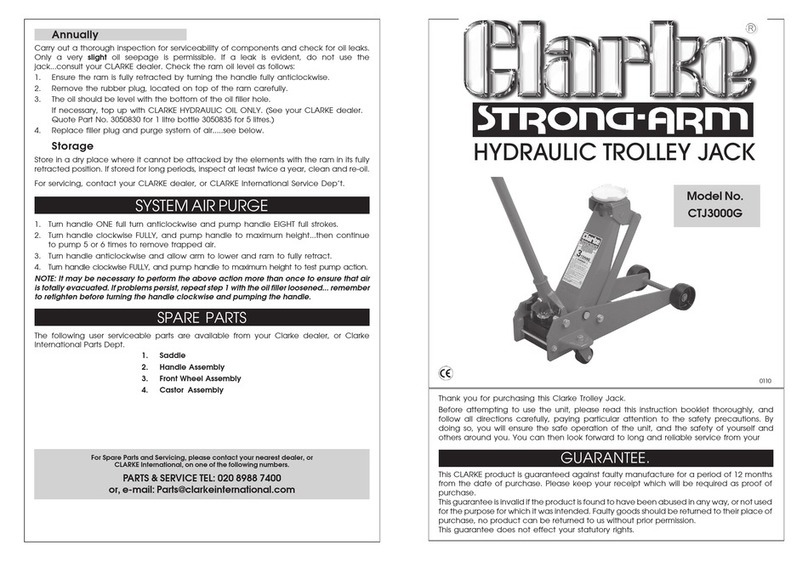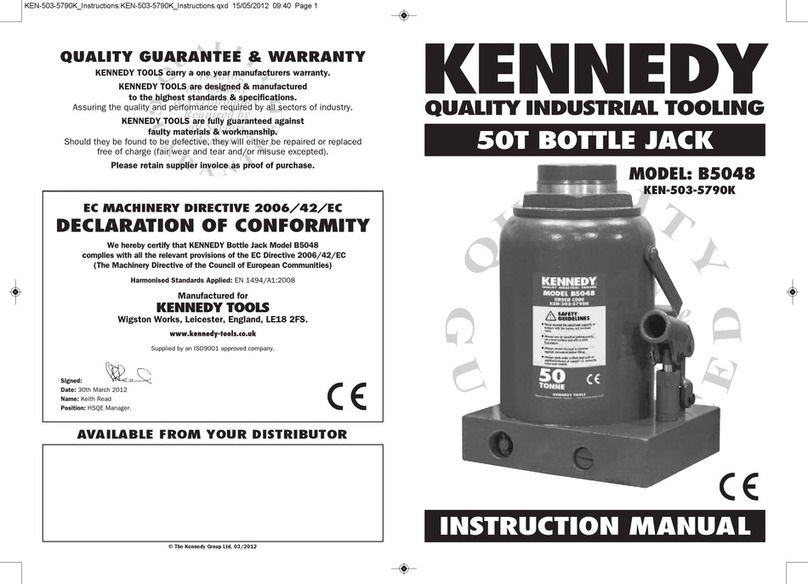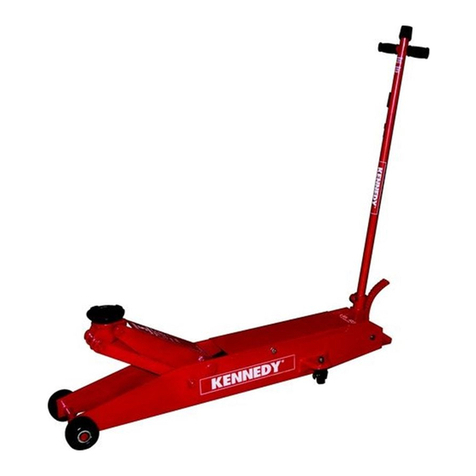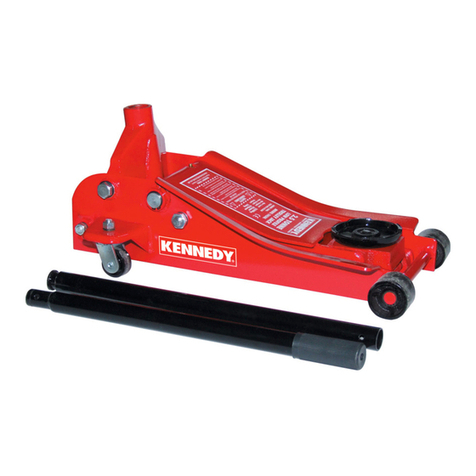
2 3
Model Max. Load Min. Height Max. Height Weight Order Code
Number (Kg/Tonne) (mm/inches) (mm/inches) (Kg) KEN-503
KSJ010 1,000/1 88/37/
16” 383/151/
16” 2.81 -5920K
thoroughly recommends reading these instructions before using the scissor
jack, even if you have used a scissor jack on a vehicle before. eading these instructions
carefully and understanding them fully will enable you to raise a vehicle correctly and will
prevent injury to yourself or someone else as well as prevent damage to the vehicle and
equipment.
Crank Handle
Socket 1
Crank
Handle
Saddle
1 tonne (metric ton or t) = 1000Kg
1 ton (imperial ton) = 2240lbs (1016Kg)
Before each use of the scissor jack, a visual inspection should be carried out, checking for cracks, cracked
welds and missing or damaged parts. If it appears to be damaged in any way, it should not be used and
removed from service immediately.
·Keep the scissor jack clean.
·When not in use, always leave the jack in the fully closed position.
·Periodically apply grease to all moving parts.
Scissor jacks are designed to only raise a vehicle and for changing one wheel at a
time. To work underneath a vehicle, a trolley jack and jack stands must be used.
BEFO E CHANGING THE WHEEL
1. Park the vehicle on a firm and level surface.
2. If the vehicle has a manual gear box, put it into “First”. If the vehicle is an automatic, put it into “Park”.
3. Apply the handbrake, and switch on the hazard warning lights.
4. Make sure all passengers are out of the vehicle and in safe area.
5. Place wheel chocks in front and behind the wheel which is diagonally opposite the one being changed.
6. Remove the wheel cover and loosen the wheel nuts/bolts by half a turn. If the nuts/bolts are difficult to
unscrew, it is safer for the vehicle to rock back and forth whilst it is on the ground. If the nuts/bolts can
not be unscrewed, seek professional assistance.
7. Place the spare wheel nearby and under the sill of the vehicle, this will act as a safety cushion should the
vehicle slip off the jack.
AISING THE VEHICLE
8. Having looked at the car user manual to find the most suitable location for the scissor jack, place the jack
under the car and slowly raise the vehicle by turning the crank handle clockwise (see fig. 1), until the tyre is
well clear of the ground. Remember to leave enough clearance to allow for a fully inflated tyre to be put in
its place.
9. If the vehicle or scissor jack shows any sign of instability, lower and reposition either the vehicle or the
jack.
10. Raise the vehicle and remove the wheel nuts/bolts completely and keep them in a safe place. If the
wheels are fitted to the vehicle using nuts, remember which way they go on. For most vehicles, the conical
end of the nut, goes on against the wheel.
11. Remove the wheel gently, being careful, as it will be heavy and dirty and place it flat under the sill of the
car (as part 7).
12. Fit the spare wheel, ensuring that it is put on the correct way round.
13. sing only moderate pressure, tighten the wheel nuts/bolts in a diagonal sequence as shown in fig. 2.
This will ensure the wheel is correctly centred.
LOWE ING THE VEHICLE
14. Lower the vehicle by turning the crank handle anti-clockwise (see fig. 1), until the wheel just touches the
ground and then fully tighten the wheel nuts/bolts with your full strength in a diagonal sequence (see fig. 2).
15. Fully lower and remove the scissor jack and the spare wheel from beneath the vehicle.
16. Remove the wheel chocks.
,$+$%% "%$'*$,$',(*$- - #$% !$,, .$,#, &)(**/+)* .# %(- &)#
·Always park the car on a firm and level surface.
·Always apply the hand brake and put the vehicle in “First” gear if it is a manual gear
box or “Park” if it is an automatic vehicle, with the engine switched off before using
the scissor jack. Do not switch on the engine whilst the vehicle is raised off the
ground.
·Always switch on the hazard warning lights to warn other motorists of your situation.
Except for motorways, use a red warning triangle positioned not less than 45 metres
(147 feet) behind your vehicle.
·Always remove heavy luggage from the vehicle before raising it.
·Always position the scissor jack under the vehicle at points specified by the vehicle
manufacturer.
·Always rest the base of the scissor jack on a firm and level surface which is able to
take the load. Do not position the scissor jack on metal gratings or manhole covers.
·Always seek professional advice before using the scissor jack on a caravan, light trailer
or a three wheeled vehicle.
·Always store the scissor jack in a secure place.
·Always use jack stands when working underneath a vehicle.
·Never change a flat tyre on the hard shoulder of a motorway. Breakdown patrols are
trained to do it safely and their hazard lights are more visible. Ensure you and your
passengers get out of the vehicle and wait in a safe area away from the vehicle and
preferably behind a safety barrier.
·Never allow people to stay in the vehicle or get into a vehicle which is being raised.
·Never exceed the rated load capacity.
·Never go underneath a vehicle which is being raised.
·Never lean against the raised vehicle.
·Never lift more than one wheel at a time.
·Never put an additional saddle or support on top of the scissor jack or make any
modifications to it.
Anti-clockwise
to lower
Clockwise
to raise
Fig. 1 Fig. 2
3
24























